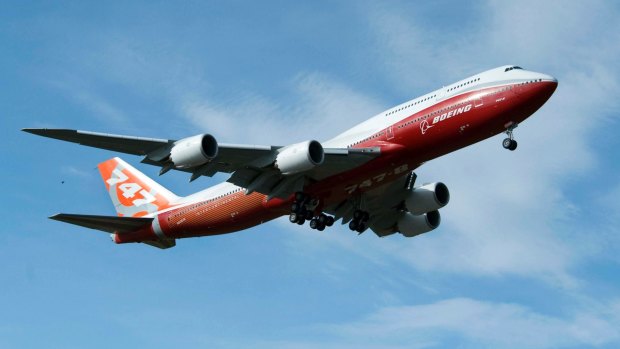This was published 6 years ago
Boeing 2017 commercial aircraft forecast doesn't include 747 jumbo jet, Airbus A380
By Julie Johnsson
Boeing sees the future, and it doesn't include jumbo passenger jets. Not its own iconic 747. Not the Airbus A380.
The US planemaker has dropped the category reserved for four-engine behemoths from its annual forecast for the commercial-aircraft market. Instead, Boeing predicts that airlines will use more efficient twin-engine jets for long-range flights -- like its 787 Dreamliner and 777X, or a mid-market plane that's on the drawing board.
By leaving so-called very large aircraft off its two-decade projection for a $US6.05 trillion ($A800 trillion) jetliner market, Boeing said it was reflecting a market reality: There is little to no chance of reviving sales of those models. The Chicago-based company and Airbus already had pared production of their biggest aircraft as orders dwindled, and Boeing has warned it may stop making the passenger version of the 747-8, the latest generation of the model.

The 747-8 jumbo jet has not been a great seller for Boeing.Credit: Boeing
"We don't see much demand for really big aircraft going forward,'' Randy Tinseth, Boeing's vice president for marketing, said at a briefing ahead of the Paris Air Show, which began Monday. "We find it hard to believe that Airbus will deliver the rest of their A380s in backlog.''
Airbus still sees a long-term market for the planes although it didn't log a single A380 sale last year. The Toulouse, France-based manufacturer says airlines will need larger jets as passenger traffic doubles and congestion limits the number of flights into megahubs, particularly in Asia and the Middle East.
The European company projects potential industrywide sales of 1400 of the largest commercial aircraft, valued at $US454 billion through 2037. That compares with Boeing's 20-year forecast for 80 deliveries that Tinseth outlined Tuesday at a Paris show presentation.
The biggest airplane in the market moving forward is going to be the 777X.
"They would do that," John Leahy, Airbus's sales chief, said of Boeing's slashed forecast for very large airliners. "The 747-8 isn't selling. We have no intention of sharing that market with them."
As the jumbo era ends at Boeing, the planemaker sees a new market emerging for mid-range airplanes overlapping the largest single-aisle and smallest twin-aisle jets. That differs from the stance at Airbus, which announced plans at the Paris show to make enhancements to the A380 in the hopes of one day reviving orders.
Lighter Gauge
"They went big and heavy, we went small and efficient," said Mike Delaney, Boeing vice president and general manager for airplane development. "We'll overfly our competitors, put a lighter gauge on things."
Airbus is refining the double-decker A380's design, including adding 4.7-metre winglets, to boost fuel efficiency by as much as four per cent. Tinseth dismissed the strategy. "Putting winglets on an airplane that's too big doesn't make that airplane any smaller," he said.
The mid-range model Boeing is developing would seat between 220 and 270 travellers and fly about 5000 nautical miles (9260km). The goal is to spur growth with jetliners that avoid hubs and link smaller cities on routes that aren't properly matched to today's aircraft. Think Washington to Prague, Japan to India, or within China's "Golden Triangle'' of Shanghai, Guangzhou and Beijing.
Airlines also could use the new jet -- dubbed the 797 or NMA, for new mid-market airplane -- on transcontinental flights to replace aging Boeing 757 and 767 jets. Budget carriers could graduate from single-aisle jets to the larger planes for more-popular routes.
Tinseth projects a potential market of 4000 to 5000 sales in that segment over 20 years.
See: Boeing 797 concept wins over airlines
Airbus has already made advances in that market with its largest single-aisle plane, the A321neo, and is exploring a stretched version that would carry more than 240 passengers. While that narrow-body would probably be cheaper than the new Boeing dual-aisle, the U.S. company sees a competitive advantage in a design that lets people board and disembark far more quickly.
Single-Aisles Dominate
Single-aisle aircraft like the Airbus A320 and Boeing 737 will still rule the market, accounting for nearly three-quarters of total sales, according to Boeing's forecast. The planemaker predicts a need for 29,530 narrow-bodies valued at $US3.18 trillion through 2036.
The next most popular type will be small wide-body aircraft, like the Boeing 787 Dreamliner and Airbus A330, accounting for 5,050 deliveries or 12 percent of forecast sales, Boeing predicts.
Sales of very large aircraft will probably be confined to Boeing's niche-market 747-8 freighter and a handful of jets for VIPs, like the next Air Force One for the US president.
The hump-backed 747 -- which in 1970 ushered in a new era of mass long-range travel -- eventually will be replaced at the top of the jetliner food chain by Boeing's 777X. The first delivery for that 400-seat plane is scheduled for 2020.
"The biggest airplane in the market moving forward is going to be the 777X," Tinseth said.
Bloomberg
What's your favourite aircraft to fly on? Vote in our poll below.
See also: Once 'queen of the skies', the iconic 747 will soon be just a flying truck
See also: Flight test: The best seat on a Qantas 747 at no extra cost
Sign up for the Traveller newsletter
The latest travel news, tips and inspiration delivered to your inbox. Sign up now.